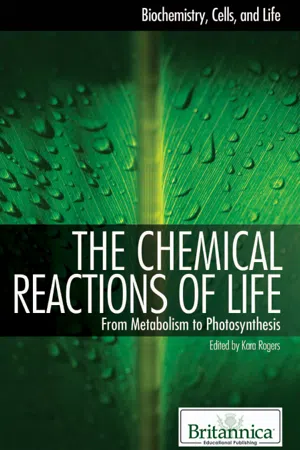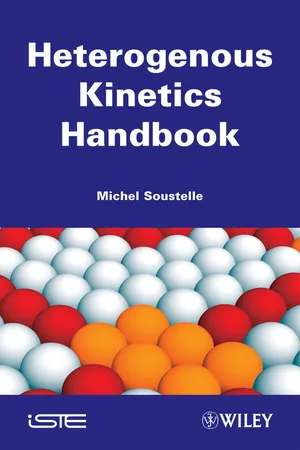Chemistry
Decomposition Reaction
A decomposition reaction is a type of chemical reaction in which a single compound breaks down into two or more simpler substances. This reaction is usually initiated by heat, light, or electricity and is the opposite of a synthesis reaction. The products of a decomposition reaction can be elements, compounds, or a mixture of both.
Written by Perlego with AI-assistance
Related key terms
Related key terms
1 of 4
Related key terms
1 of 3
3 Key excerpts on "Decomposition Reaction"
- eBook - ePub
The Chemical Reactions of Life
From Metabolism to Photosynthesis
- Britannica Educational Publishing, Kara Rogers(Authors)
- 2010(Publication Date)
- Britannica Educational Publishing(Publisher)
Chemists often classify reactions on the basis of the overall result. Examples of reactions classified in this way include Decomposition Reactions, substitution, elimination, and addition reactions, and polymerization reactions. As previously noted, many reactions defy simple classification and may fit in several categories.DECOMPOSITION REACTIONSDecomposition Reactions are processes in which chemical species break up into simpler parts. Usually, Decomposition Reactions require energy input. For example, a common method of producing oxygen gas in the laboratory is the decomposition of potassium chlorate (KClO3 ) by heat.2KClO3 (s) → 2KCl(s) + 3O2 (g)Another Decomposition Reaction is the production of sodium (Na) and chlorine (Cl2 ) by electrolysis of molten sodium chloride (NaCl) at high temperature.2NaCl (l) → 2Na (l) + Cl2 (g)A Decomposition Reaction that was very important in the history of chemistry is the decomposition of mercury oxide (HgO) with heat to give mercury metal (Hg) and oxygen gas. This is the reaction used by 18th-century chemists Carl Wilhelm Scheele, Joseph Priestley, and Antoine-Laurent Lavoisier in their experiments on oxygen.2HgO(s) → 2Hg (l) + O2 (g)SUBSTITUTION , ELIMINATION, AND ADDITION REACTIONSThe terms substitution, elimination , and addition are particularly useful in describing organic reactions. In a substitution reaction, an atom or group of atoms in a molecule is replaced by another atom or group of atoms. For example, methane (CH4 ) reacts with chlorine (Cl2 ) to produce chloromethane (CH3 Cl), a compound used as a topical anesthetic. In this reaction, a chlorine atom is substituted for a hydrogen atom.Substitution reactions are widely used in industrial chemistry. For example, substituting two of the chlorine atoms on chloroform (CHCl3 ) with fluorine atoms produces chlorodifluoromethane (CHClF2 ). This product undergoes a further reaction when heated strongly.2CHClF2 (g) → F2 C=CF2 (g) + 2HCl(g)This latter reaction is an example of an elimination reaction, a hydrogen atom and a chlorine atom being eliminated from the starting material as hydrochloric acid (HCl). The other product is tetrafluoroethylene, a precursor to the polymer known commercially as Teflon. - eBook - ePub
- Michel Soustelle(Author)
- 2013(Publication Date)
- Wiley-ISTE(Publisher)
Chapter 13Decomposition Reactions of Solids
A Decomposition Reaction of a solid is a reaction that starting from a solid A leads to another solid B , with the release of one or more gas. Such a reaction is written as:These reactions are characterized by the change of an unstable initial solid phase under the experimental conditions into another stable final solid phase. The two solids A and B are different in their compositions and crystal structures.These reactions generally occur under the effect of temperature, given pressure conditions of gases, and sometimes the effect of electromagnetic radiations with suitable wavelengths.The majority of these reactions are possible in both directions (the opposite reaction of a decomposition is a gas-solid reaction; see Chapter 15 ) according to the conditions of temperature and pressures given by thermodynamics. The studies of the reactions in the direction of the decomposition are generally carried out under conditions that are not very far from equilibrium conditions in order to obtain suitable speeds (not too fast) for measurement; then, we will not be able to neglect the opposite reactions of the elementary steps. Including the creation of a new solid phase, Decomposition Reactions use the two processes of nucleation, in general on the surface, and growth, according to the methods developed in Chapters 10 and 11 .13.1. Classifications of Decomposition Reactions
Two kinds of classifications have been proposed for these reactions: one is based on the sign of the enthalpy of the reaction and the other on the origin of the released gas molecule.13.1.1. Classification according to the sign of the enthalpy
Some authors proposed to classify the Decomposition Reactions into two categories: exothermic reactions and endothermic reactions. This distinction is important for the experimental approach because concerned solids generally have poor heat conduction; then, the exothermic reactions can lead to over-temperatures (heating of the sample due to the heat released and difficult to evacuate it) and the endothermic reactions can lead to the opposite phenomenon of sub-temperature. These phenomena must be, either eliminated as far as possible, or taken into account in the modeling of the kinetics. - eBook - ePub
- Adrian Dingle, Derrick C. Wood(Authors)
- 2014(Publication Date)
- Research & Education Association(Publisher)
not require using the smallest possible integers before presenting a final answer with fractional coefficients. For example, the following equations are both “balanced,” but one includes the use of fractions as coefficients, while the other uses the smallest possible integers. Some questions may require the use of only the smallest possible integers.Passage contains an image
Chapter 12
Classifying Chemical Reactions
A. Synthesis Reactions 1. Atoms and/or molecules combine to form a new compound. 2. A + B → ABI. Types of Chemical Reactionsi. Metal + non-metal → binary ionic compoundii. Non-metal + non-metal → binary covalent compoundiii. Compound + compound → compoundB. Decomposition Reactions 1. A compound breaks down into two or more substances. 2. AB → A + B (the reverse of synthesis) 3. Thermal decomposition (using heat to cause decomposition)i. Oxy-acids, when heated (and sometimes without the need for heat), decompose to form water and non-metal oxide, e.g., H2 CO3 (aq) → H2 O(l) + CO2 (g)ii. Metallic chlorates, when heated, decompose to form metal chloride and oxygen gas, e.g.,iii. Metallic hydroxides, when heated, decompose to form the metal oxide and water, e.g.,iv. Metallic carbonates, when heated, decompose to form the metal oxide and carbon dioxide, e.g.,v. Metallic oxides are often stable, but a few decompose when heated to form the metal and oxygen gas, e.g.,4. Electrical decomposition (using electricity to cause decomposition—electrolysis
Index pages curate the most relevant extracts from our library of academic textbooks. They’ve been created using an in-house natural language model (NLM), each adding context and meaning to key research topics.
Explore more topic indexes
Explore more topic indexes
1 of 6
Explore more topic indexes
1 of 4


